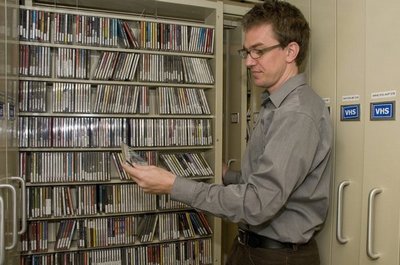January 29, 2009
Media Center offers Puget Sounds, Netflix for instructors and more
Art rock. Freak folk. Shockabilly. Never heard of these music genres? They’re closer to home than you think.
They are all part of Puget Sounds, a unique collection of local music at the Media Center on the mezzanine level in Odegaard. Media Center Head John Vallier worked with students to compile the collection, which consists of music performed and produced in the Puget Sound region. No style, genre or culture was excluded from the collection; selections range from the popular (Nirvana, Blue Scholars) to the unusual (Balkan folk).
A former archivist in ethnomusicology at UCLA, Vallier was interested in documenting the various styles of music that are created in the Puget Sound region. Last year, he led a freshman seminar in which students searched the region, from the San Juan Islands down to Olympia, for local music and reported back with their findings.
“A lot of it was done online,” Vallier explained. “The students, of course, used MySpace because there are a lot of obscure bands who have pages on there. Some people in the class were from nearby counties, so they had their own knowledge of that particular music scene and would bring that to the class.”
Vallier and his students used a $5,000 award from the Friends of the Libraries to purchase titles from local artists on MySpace, as well as CDs from other online resources. Some bands even donated their music to the collection.
“It was great that we got everything from experimental classical music to opera; we didn’t just focus on rock bands,” said Kathleen DeLaurenti, a reference and instruction librarian at UW Bothell who assisted with the class as a graduate student in the Information School. “When people think about the Northwest community, they tend to think about rock and grunge. They don’t think about the history of jazz here, which is really great. Hopefully when people look at the collection and see the variety, it will influence the way they think about music in the region, too.”
Although funds for the Puget Sounds collection have run out, Vallier said the Media Center is always appreciative of local music donations.
The catalogue of local sounds, which includes more than 500 titles, is available to browse online and CDs may be checked out from the Media Center. You can also hear selections from Puget Sounds on LibRadio, a weekly radio show hosted by Media Center Graduate Staff Assistant Cecilia Jezek, who was also a TA for Vallier’s seminar. The show airs on RainyDawg Radio Tuesdays, 11 a.m. – 1 p.m., and also includes music and spoken word from UW Libraries’ other collections.
The Puget Sounds collection is just one of many Media Center resources available to the UW community. Students, faculty and staff can also choose from an enormous selection of films on VHS and DVD, from instructional resources and documentaries to recent big-screen releases like WALL-E and Indiana Jones and the Crystal Skull.
Both the Media Center’s music and movie collections are closed, meaning they can only be browsed online. You may place holds on desired items, and even have items transferred to the Seattle campus from collections at UW Bothell and UW Tacoma. Items may be checked out for three days and repeatedly renewed unless they have other holds pending.
Vallier said the Media Center always encourages media purchase suggestions. “If someone wants something and they’re part of the UW community, we’re interested in hearing from them,” he said. “We give priority, of course, to faculty requests for instruction material, but everyone is welcome to submit requests and let us know what they’re interested in seeing.”
Vallier also said that one Media Center feature is particularly underutilized: the free Netflix service that is exclusively available to instructors. “Say an instructor wants a movie we don’t currently have; we can go ahead and request it on Netflix for them and it will be here in a few days for them to use,” he explained. “If they’re thinking, ‘Maybe I want to use this,’ or, ‘Maybe I want the library to buy this but I’m not quite sure until I actually see it,’ it’s a great tool.”
Another tool that can make media access easier for instructors and students is streaming select audio and video titles to students as part of the Libraries’ online course reserves program.
The online audio streaming is already up and running, but video streaming is a pilot program for now. Vallier said beginning spring quarter, there will be a page on the Media Center Web site where instructors can submit requests for streaming video.
“We anticipate there will be a lot of demand for it and we’re not sure if we can keep up with that right away, so we’re going to prioritize in terms of the size of the class,” Vallier said. “We really want to give those students in larger classes the ability to watch the movies online instead of having to come here all the time and check out the video or wait for it to be returned.”
Visit the Media Center Web site and blog for more information and updates on new music, movies and technological developments.



